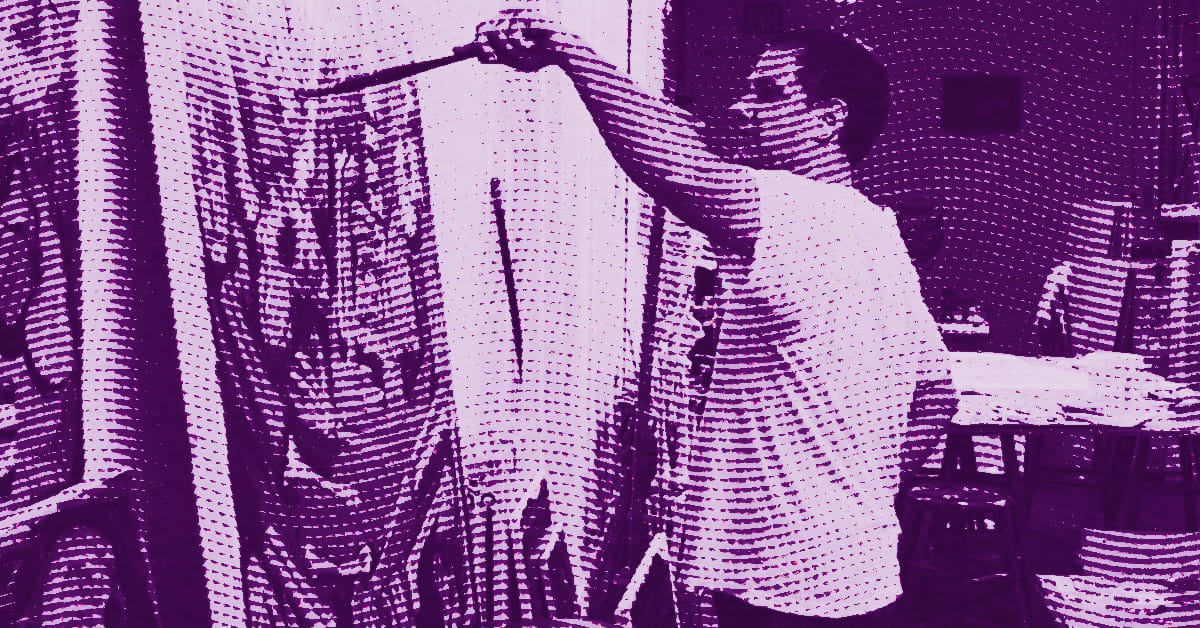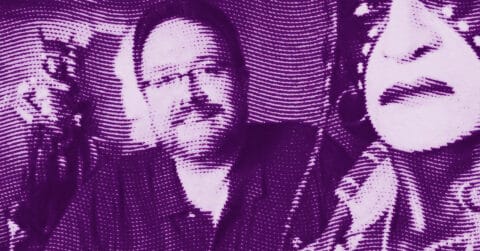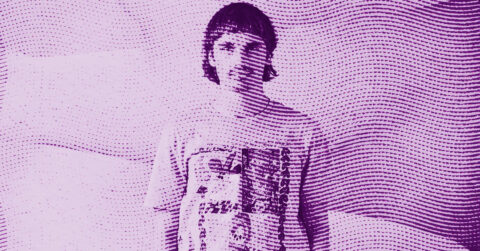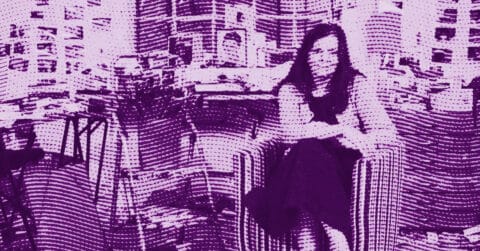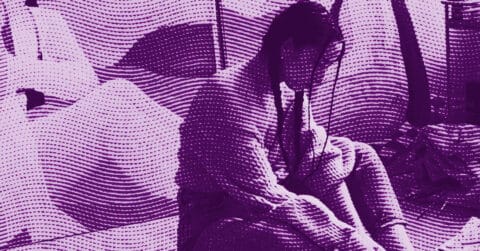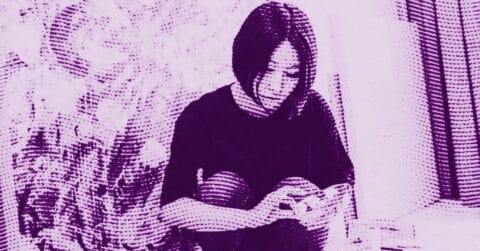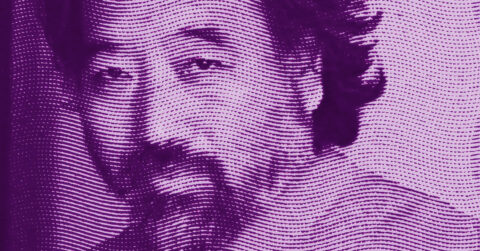Listen to me carefully, you bunch of snobs: Josh Smith paints as naturally as breathing, with that vital urgency that characterizes the true creators of our time. In his Brooklyn warehouse, transformed into a sprawling artistic complex, this artist born in 1976 on a military base in Okinawa has been developing for more than two decades a body of work that questions the very foundations of contemporary pictorial expression. His paintings, whether they depict tropical palm trees in gaudy colors, grimacing reapers, or his own signatures repeated endlessly, form an artistic corpus of troubling coherence beneath its apparent dispersion.
Smith’s work is part of that tradition of contemporary art that fully embraces its postmodern condition, navigating between sincerity and cynicism with disconcerting skill. His paintings, executed in a deliberately “careless” style, explore the ambiguous territories where authentic expression meets mechanized reproduction, raw emotion meets conceptual calculation.
The sociology of creative isolation
Josh Smith’s creative approach reveals a particularly striking sociological dimension that sheds light on the conditions of artistic production in the contemporary metropolis. His creative process revolves around what he himself calls the “locked in,” a state of voluntary isolation that can extend over several months in his Brooklyn studio-residence. This practice of creative seclusion directly questions the modes of artistic sociability in a city like New York, where competitive pressure and hyperstimulation are the fundamental conditions of creative existence.
The artist describes this paradoxical condition with remarkable lucidity: “I spend long periods alone, sometimes months. Sometimes I don’t leave my studio for six months” [1]. This statement reveals a strategy of resistance against what Georg Simmel had already identified at the beginning of the 20th century as the alienating effects of modern metropolitan life. Smith develops a form of reversed “blasé”: rather than protecting himself from urban over-information through indifference, he chooses radical subtraction.
This practice of isolation is not a mere artistic misanthropy but part of a complex psychic economy where solitude becomes the necessary condition for the emergence of authentic expression. “To be a good artist, I think you have to feel like you are falling. It’s uncomfortable and it’s a somewhat unhealthy way of life” [1]. This metaphor of falling echoes the analyses that Zygmunt Bauman devoted to “liquid modernity,” where the contemporary individual must constantly reinvent their modes of existence without being able to rely on stable structures.
Smith’s studio operates as an autonomous social microcosm, equipped with multiple workspaces, a library with metal shelves climbing up to the ceiling, and even an underground garden where the artist grows his greens. This spatial configuration expresses a desire for self-sufficiency that responds to the dysfunctions of contemporary urban sociability. The artist does not just flee society; he reconstructs a miniaturized and controlled version of it.
The sociological dimension of this practice also appears in the way Smith links creation and social mediation. His paintings become vehicles for delayed communication with an audience he cannot meet directly. “I try to do my work so that it pleases many different people: children and adults. I want people to look at my work and understand exactly how it was made” [1]. This technical transparency constitutes a form of social generosity that compensates for the isolation of the creative process.
Smith’s exceptional productivity is illuminated from this sociological perspective. His repetitive series, palms, signatures, and monochromes, function as rituals to ward off loneliness. The repetition of the pictorial gesture creates an alternative temporality to that of urban socialization, a cyclical and soothing temporality that allows the artist to regain a form of contact with the world without suffering its violences.
This sociological approach reveals how contemporary art develops survival strategies in the face of the pathologies of advanced modernity. Smith’s isolation is not an escape from the social but a method to reveal its contradictions and to invent new forms of collective bond through the artwork.
Tragic hedonism: a psychoanalytic approach
Josh Smith’s work unfolds a complex emotional register that invites a psychoanalytic reading attentive to defense mechanisms and unconscious formations structuring his artistic production. His paintings reveal what one could call tragic hedonism, a libidinal economy where the pursuit of aesthetic pleasure constantly clashes with existential anxiety and depressive manifestations.
The artist openly discusses his relationship to depression: “Many of my works illustrate my depression, especially the abstract paintings” [1]. This explicit acknowledgment of the symptomatic dimension of art opens the way to an understanding of the sublimation mechanisms at work in his practice. According to Freudian theory, sublimation allows the diversion of drives towards socially valued objects, transforming psychic suffering into aesthetic creation.
Smith’s repetitive series function as obsessive formations attempting to master anxiety through the ritualization of the creative gesture. His tropical palms, compulsively painted in saturated colors, evoke fantasies of escape to an Edenic elsewhere that sharply contrasts with the reality of his isolation in Brooklyn. This dialectic between desire for escape and real confinement reveals denial mechanisms characteristic of certain neurotic organizations.
The practice of repeated signatures constitutes a particularly revealing case of this psychic dynamic. By obsessively painting his own name, Smith stages a fundamental narcissistic issue: the compulsive affirmation of the self in the face of the anxiety of disappearance. “Josh Smith” becomes a floating signifier, emptied of its subjective charge through repetition itself, revealing the fundamental inconsistency of modern identity.
The recent shift towards red monochromes in the exhibition “Living with Depression” marks an intensification of this psychic economy. Red, a color traditionally associated with the life drive but also with aggression and blood, functions as a projective screen where the most archaic affects unfold. The artist himself acknowledges this ambivalence: “Red is repulsive. It is also seductive” [2].
This psychoanalytic approach also sheds light on the particular relationship Smith has with creative temporality. His periods of prolonged isolation evoke regressive mechanisms through which the subject tries to regain a state prior to traumatic socialization. “There is nothing like going to your studio with two bags of Fritos and six Red Bulls. And then, you know, you work all night and in fact, you are alone” [1]. This ritualization of creative solitude reveals an attempt to reconstruct a transitional space, in the sense that Donald Winnicott gave to this notion.
The artist’s exceptional productivity can be understood as a reaction formation in response to depressive anxiety. The compulsive accumulation of works functions as a denial of loss and finitude. “Having a lot of canvases makes me feel rich. Because you could do anything with these. I don’t know what to do with money, but I know what to do with canvases” [1].
This psychic economy reveals how contemporary art can function as a therapeutic device, allowing the subject to metabolize his internal conflicts through plastic creation. Smith’s works constitute attempts at symbolic repair, efforts to restore meaning and coherence to an existence weakened by the pathologies of late modernity.
The epiphany of the everyday and resistance to time
In Josh Smith’s creative labyrinth emerges an aesthetic of temporal resistance rooted in a particularly sophisticated philosophy of the moment. His works, although apparently gestural and spontaneous, reveal a deep meditation on modes of presence in the world and on possibilities for saving the everyday through art.
Smith’s approach fits within the modern tradition that, since Charles Baudelaire, seeks to extract the eternal from the transient. His tropical palms, painted in the urgency of repetitive gestures, function as epiphanies of the banal, transforming tourist clichés into aesthetic revelations. This alchemy of the everyday evokes the analyses that György Lukács dedicated to “disentanglement” in his Theory of the Novel, the ability of art to reveal the extraordinary lurking in the ordinary.
Smith’s creative temporality operates according to a logic of intensive accumulation that recalls strategies developed by historical avant-gardes to resist modern acceleration. His repetitive series are not a mere compulsion but a method to densify time, to create pockets of resistance against the destructive speed of the contemporary metropolis. “I paint in series of very specific and simple subjects, fruits, animals, landscapes, and myths, which often appear to be made feverishly and in pursuit of an honest and unmediated expression” [1].
This quest for immediacy paradoxically reveals a keen awareness of mediation. Smith develops an aesthetic of “bad” painting that fully embraces its constructed and artificial nature. His colors “straight out of the tube,” his “careless” gestures, his speed of execution are all strategies to short-circuit the traditional sublimation mechanisms of art and to regain a form of direct contact with reality.
This temporal approach is articulated around a particular conception of creative finitude. Smith regularly mentions the feeling that every exhibition could be the last: “I feel like every exhibition could be my last exhibition” [1]. This awareness of precariousness transforms every pictorial gesture into an existential urgency, giving his works a particular intensity akin to what Heidegger called “being-towards-death.”
The artist’s studio operates like a time machine where different chronological layers overlap. His paintings overlap, cover each other, and recycle in a continuous process of memorial stratification. “I paint over many things, to the point where you could say a canvas is too thick” [1]. This practice of overpainting reveals a conception of time where each work carries the traces of its previous states within it.
The philosophical dimension of this approach is clearly evident in the way Smith articulates repetition and difference. Each palm tree, each signature, each monochrome constitutes an infinitesimal variation that reveals the impossibility of pure reproduction. This aesthetics of différance, in the sense Jacques Derrida used the term, transforms repetition into a method of revealing the unique and irreplaceable.
Smith’s work thus develops an alternative temporality to that of contemporary cultural consumption. His paintings require time, patience, a form of slowed attention that contrasts with the economy of the instantaneous characteristic of our era. They offer an experience of duration that resists the logics of planned obsolescence and the accelerated rotation of images.
Towards an authentic artificiality
At the end of this critical journey through Josh Smith’s pictorial universe, it is appropriate to measure the true scope of his artistic enterprise and evaluate his contribution to contemporary art. His work reveals a remarkable strategic intelligence that allows him to navigate between the pitfalls of postmodern cynicism and those of neo-expressionist naivety, inventing a third path that could well constitute one of the most relevant responses to the aesthetic challenges of our time.
Josh Smith’s singular strength lies in his ability to fully embrace the constitutive artificiality of contemporary art while preserving a form of expressive authenticity. His paintings never claim pure spontaneity, but they also do not fall into cold conceptual calculation. They develop what one might call an “authentic artificiality,” a constructed sincerity that corresponds exactly to the conditions of existence of contemporary subjectivity.
This aesthetic position reveals a profound understanding of the anthropological mutations of our time. In a society where authenticity itself has become a commodity, where spontaneity is programmed, and where emotion is formatted, Smith proposes a path of emancipation through lucid acceptance of these contradictions. His works teach us to be authentically artificial, sincerely constructed, truly fake.
The recent evolution of his work, marked by the introduction of social networks and YouTube into his artistic practice, confirms this strategic intelligence. Rather than nostalgically resisting new communication technologies, Smith integrates them as new artistic mediums, transforming Instagram into a work of art and YouTube into a public studio. This approach reveals a remarkable adaptability that allows him to maintain the relevance of his aesthetic inquiry amidst the rapid transformations of the contemporary cultural landscape.
The sociological impact of his work is also particularly interesting. By meticulously documenting his processes of creative isolation and theorizing his own practice of productive solitude, Smith offers an alternative model of artistic success that does not rely on traditional socializing. He demonstrates that it is possible to build an international career while preserving a form of interiority and personal authenticity.
His contribution to the history of contemporary painting appears decisive. By reconciling figuration and abstraction, expressiveness and conceptualism, speed of execution and theoretical sophistication, Josh Smith opens up new possibilities for a medium that many considered exhausted. His works prove that painting can still surprise, move, and challenge without renouncing its critical dimension.
Josh Smith’s work constitutes a privileged laboratory for understanding the conditions of possibility of art in contemporary society. It reveals how a creator can preserve his aesthetic autonomy while adapting to market constraints, how he can maintain a high formal demand while embracing the entertaining dimension of art, how he can claim his uniqueness while proposing a universally accessible experience.
This paradoxical synthesis of opposites could very well constitute one of the most fruitful responses to the aporias of contemporary art. By rejecting the ease of radicalism and that of conformism, Josh Smith invents a middle path that preserves the complexity of reality without giving up aesthetic effectiveness. His work teaches us that it is possible to be simultaneously popular and demanding, accessible and sophisticated, traditional and innovative.
Perhaps the most precious lesson of this work lies here: in its demonstration that art can still constitute a space of authentic freedom, provided that one lucidly accepts the constraints of one’s time and transforms them into creative material. Josh Smith shows us that it is possible to paint today without nostalgia or cynicism, with the kind of practical wisdom that characterizes true artists of their time.
- Ross Simonini, “The Interview: Josh Smith”, ArtReview, 2019
- “Josh Smith: Living with Depression”, Spike Art Magazine, 2023

